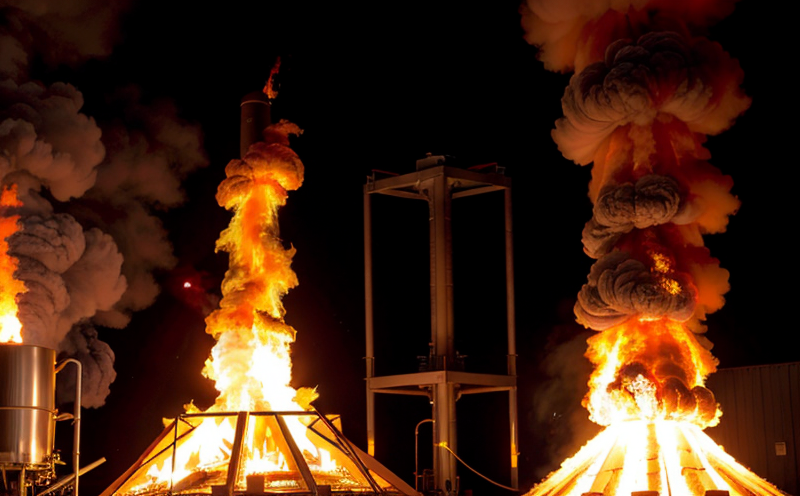Gypsum Board Flammability Testing
Gypsum board is a widely used construction material due to its versatility and performance in fire safety. This service focuses on testing gypsum boards for flammability, ensuring they meet stringent safety standards.
The primary objective of this testing is to assess the combustibility properties of gypsum panels under controlled conditions. This information is crucial for architects, builders, and regulatory bodies to ensure compliance with international codes and standards. Understanding these tests helps in evaluating how a material behaves when exposed to fire, which can significantly impact building safety.
The testing process involves subjecting specimens of gypsum boards to various thermal environments to observe their behavior. This includes assessing the time it takes for ignition, the rate at which flames spread, and the amount of heat released during combustion. These parameters are critical in determining a material’s fire resistance rating (FRR).
The results from these tests provide valuable insights into the fire performance characteristics of gypsum boards, enabling informed decision-making regarding their use in various applications. This information is especially important for ensuring compliance with fire safety regulations and codes such as ASTM E84 (Standard Test Method for Surface Burning Characteristics of Building Materials), ISO 13501-1, and EN 13679.
Flammability testing of gypsum boards also helps in identifying potential improvements to the material's fire resistance. This can include modifying the composition or adding fire-retardant additives. By conducting these tests, manufacturers can enhance the safety features of their products, ensuring they meet stringent requirements and contribute positively to public safety.
Compliance with relevant standards ensures that gypsum boards are safe for use in residential, commercial, and industrial settings. This service plays a vital role in maintaining high-quality building materials that protect lives and property from the dangers of fire.
Applied Standards
The testing of gypsum boards for flammability is governed by several international standards, including ASTM E84, ISO 13501-1, and EN 13679. These standards provide detailed protocols and criteria for conducting the tests to ensure consistency and reliability.
- ASTM E84: This standard specifies test methods used to determine the relative combustion characteristics of building materials. It involves testing specimens under controlled conditions, measuring flame spread and smoke development indices.
- ISO 13501-1: This international standard provides a comprehensive approach for determining the fire behavior of materials using horizontal tunnel tests. The test results are used to derive fire performance parameters that can influence design decisions in building construction.
- EN 13679: This European standard specifies methods for assessing the resistance of gypsum boards to heat and flame, focusing on both surface burning characteristics and structural integrity during a fire event.
The use of these standards ensures that the testing process is standardized across different regions, facilitating international acceptance and recognition. Compliance with these standards also helps in ensuring that gypsum boards meet the stringent requirements set by regulatory bodies and building codes.
International Acceptance and Recognition
- The results of flammability tests for gypsum boards are widely recognized across various countries, including the United States, Europe, Canada, and Asia. These results ensure that materials meet local fire safety codes.
- Gypsum board manufacturers who comply with these standards can export their products internationally without facing significant barriers to entry in different markets.
- Regulatory bodies rely on consistent testing methods to ensure the safety of construction materials, making adherence to international standards essential for industry-wide acceptance.
The global recognition of these tests underscores the importance of maintaining high-quality standards in building materials. By adhering to these standards, manufacturers can demonstrate their commitment to safety and quality, thereby gaining a competitive edge in the market.
Use Cases and Application Examples
| Application Example | Description |
|---|---|
| Residential Construction | Gypsum boards are commonly used in residential construction for wall and ceiling applications. Testing ensures that these materials meet fire safety requirements, providing peace of mind to homeowners. |
| Commercial Buildings | In commercial settings, gypsum boards contribute to the overall fire safety strategy. They are used in office buildings, hotels, and retail spaces to ensure compliance with local regulations. |
| Industrial Facilities | Gypsum boards play a crucial role in industrial facilities by providing fire resistance and structural integrity during emergencies. Testing helps validate these critical properties. |
The results of flammability tests for gypsum boards are essential for architects, engineers, and building owners to make informed decisions about material selection. These tests ensure that the materials used in construction projects meet the necessary fire safety standards, thereby enhancing overall building safety.





